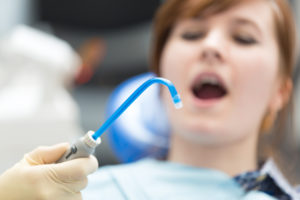It is the dental assistant’s responsibility to maintain mouth suction, moisture control and keep a clean oral environment, when they are assisting with a dental procedure. The dental assistant is responsible for keeping the patient’s mouth free of excess saliva, blood, tooth fragments and other dental materials with the use of suction. Common procedures that use dental suction and moisture control techniques include teeth cleaning, amalgam filling, composite filling and root canal.
The different suction and moisture control techniques include oral evacuation systems, rinsing the oral cavity, and teeth isolation. The dental assistant will become familiar with the procedures that utilize each type of suction and moisture control technique and the tools used during dental procedure.
Oral Evacuation System
Oral evacuation describes the process of removing excess fluid and debris from the patient’s mouth. The oral evacuator is used throughout each dental procedure. The two types of oral evacuation systems include saliva ejectors and high-volume evacuators.
 Saliva Ejector – a small oral evacuator that is used for moisture control during less-invasive dental procedures. The saliva ejector can remove excess fluids but is not strong enough to remove solid debris. Some of the dental procedures a saliva ejector will be used for including prophylaxis, placement of sealants and fluoride treatments.
Saliva Ejector – a small oral evacuator that is used for moisture control during less-invasive dental procedures. The saliva ejector can remove excess fluids but is not strong enough to remove solid debris. Some of the dental procedures a saliva ejector will be used for including prophylaxis, placement of sealants and fluoride treatments.
High-Volume Evacuators – used to remove saliva, blood, water and debris during a dental procedure. The high-volume evacuator can also be used to retract the tongue and cheek away from the part of the mouth the dentist is working on. The evacuator is also used to reduce the bacterial aerosol caused by a high-speed handpiece. The high-volume evacuator has two distinct tips, the operative suction tip and the surgical suction tip. The operative suction tips are larger and can be used throughout the mouth during a dental procedure. The surgical suction tip is smaller and used primarily to control the moisture within the surgical site.
The dental assistant is responsible for placing the evacuator in the patient’s mouth before the dentist positions the handpiece and the mouth mirror. The dental assistant will position the suction tip near the tooth that is being operated on.
The oral evacuation systems will need to be maintained on a daily basis. The dental assistant will want to follow the infection control policies when handling contaminated items. They will check the disposable traps weekly and replace if needed. The dental assistant will use antimicrobial solution to flush out the hoses each day and open the saliva ejector hoses, cleaning and replacing the screens as needed.
Rinsing the Oral Cavity
The dental assistant will want to rinse the patient’s mouth frequently to clear the debris for the dentist and keep the patient comfortable. The two types of rinsing procedures used for moisture control by the dental assistant include limited-area rinsing and full-mouth rinsing. To complete the rinsing process, the dental assistant uses the air-water syringe.
Limited-Area Rinsing – used when the dentist exits the mouth during a dental procedure and pauses for inspection. The dental assistant must do the rinsing in a way that doesn’t slow down the dental procedure.
Full-Mouth Rinsing – used when the patient’s entire mouth needs rinsing. Full-mouth rinsing may be used after a long restorative procedure.
Air-Water Syringe – connected to the dental unit and provides air, water or a combination of the two through a small sterile tip. The dental assistant will want to direct the syringe tip toward the tooth that the dentist is working on. They will also use the air on the mouth mirror continuously when the dentist is using it to see in back of the mouth. When the dental assistant hears a dentist pause, the dental assistant will want to rinse and dry the site.
Isolation of Teeth
During some procedures the teeth must be isolated to be kept dry. The three different types of isolation a dental assistant can use include cotton rolls, a dry-angle technique or a dental dam.
Cotton Roll Isolation – a pre-shaped cotton roll is placed close to the salivary gland ducts to absorb the flow of saliva. This type of isolation is used during examinations, sealant application, cement casting and other simple dental procedures.
Dry-Angle Isolation – isolation technique that uses a triangular absorbent pad. These pads block the flow of saliva and protect the tissues during a dental procedure. The dental assistant will want to replace the pad if they become soaked before the dental procedure is complete.
The Dental Dam – a thin and stretchy material, made from a latex rubber material or a silicone latex-free material, that can be used to separate teeth for moisture control while the dentist works in the patient’s mouth. The dental dam is to be used as an infection control barrier, to safeguard the mouth from contact with debris, to stop the patient from swallowing the debris, and improves allows access to the patient’s teeth by retracting the lips, tongue and gingiva.
A dental assistant will learn suction and moisture control techniques while attending a career college dental assistant training program and while participating in an externship. The foundation that is created will help the dental assistant build their skills before working in an entry-level position in a dental office or clinic.
Interested in learning more about how the dental assistant supports the dentist during a procedure with suction and moisture control techniques? Are you ready to learn more about how to become a dental assistant? The Dental Assistant training program at Meridian College provides extensive hands-on training including a school externship at a dental office where you will assist the dentist to treat actual patients.
Contact Meridian College today to learn more about becoming a dental assistant.